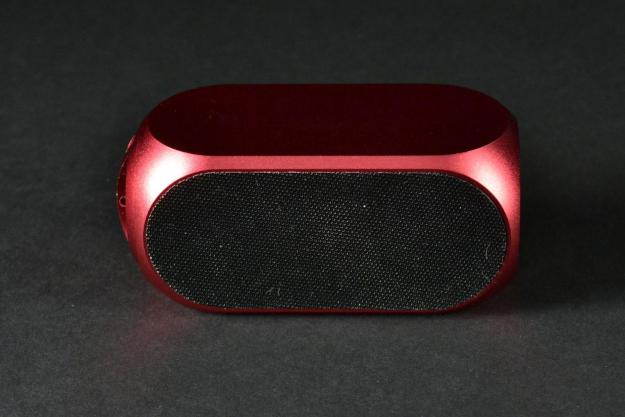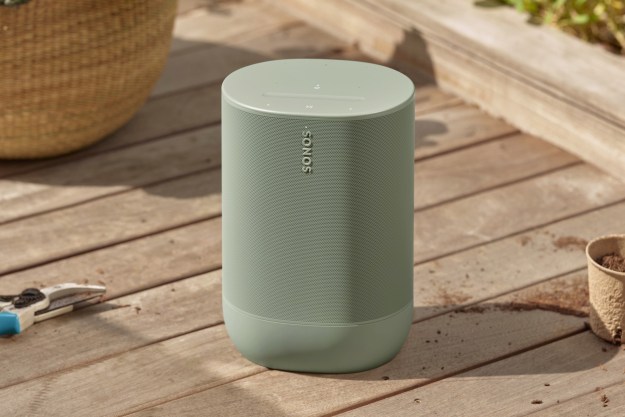
“The QUBE 2 far outperformed our aging Macbook’s speakers, offering more presence, better clarity, and a much higher max volume.”
- Clear and present midrange
- High max volume
- Cool, solid design
- Uber-portable
- Poor Bluetooth connection
- Pricey for the performance
- Very little bass response
When it comes to Bluetooth speakers, there’s portable, and then there’s super-duper, lost-in-your-backpack portable. The QUBE 2 from Matrix Audio (available at $80) is of the latter variety. Advertised as the world’s smallest stereo speaker, the keychain-sized device promises “mind blowing stereo sound” from its tiny metallic body, but after seeing its meager dimensions, we decided we’d settle for it outperforming our paltry laptop speakers. With these more manageable expectations, we synced the QUBE 2 to our iPhone 5 and let it rip. Here’s how it fared.
Features and design
We think most will agree that the QUBE 2 strikes a cool aesthetic. Carved into a slim block of aluminum with rounded lines, and a glittering fuchsia paint job, the sample we received looks part speaker, part post-modern paperweight. The unit weighs 185 grams (that’s .40 lbs. for you metrics haters), and measures roughly 3 inches long and 1.5 inches deep and wide. Along with our purplish-red model, the QUBE 2 also comes in black and silver.
Beneath the QUBE 2’s ovular screen are two small drivers roughly 1-inch in diameter. Both are powered by a 6-watt amplifier. That may not sound like a lot of juice, but it’s a pretty hefty kick at this size. Each subsequent side of the block mirrors the oval shape of the front screen, bringing some appreciated symmetry to the design.

Battery life is estimated at a max eight hours per charge, and the speaker comes equipped with a small microfiber carrying bag, a mini-USB to USB charging cable that doubles as an Aux input cable, and the aforementioned leather strap with metal fastener.
Performance
Referring to our original goal, the QUBE 2 far outperformed our aging Macbook’s speakers, offering more presence, better clarity, and a much higher max volume. While a simple visual inspection of the speaker can give you a fairly accurate idea of its bass response – or complete lack thereof – the speaker did an admirable job for its size with the upper midrange and treble on the music we threw its way, spending a predictable amount of focus at the middle of the frequency range to provide clear vocals and some decent definition on snare and cymbals.
… though the speaker may be marketed around being a stereo device… there was virtually no separation between the two channels.
Moving through several genres, we were impressed with the overall color of the sound, finding little sibilance in the upper register until we cued up sucker punches like Van Halen’s “House of Pain,” which squeezed out some extremely sizzle-y crash cymbals. Aside from a few such anomalies, rock and pop tracks were generally rendered with good clarity in the guitar and synthesizers, even offering a touch of dynamic expression at the attack of instruments like pedal steel and slide guitar. However, though the speaker may be marketed around being a stereo device, as we expected, there was virtually no separation between the two channels.
As for the lower register, the speaker showed some mettle with tom drums, displaying a touch of force from the lower midrange that provided a pleasant punch to the foundation of the sound. We exposed limits in the bass quickly, however, noting several tracks in which the kick drum simply disappeared, leaving nothing behind but a soft ripple in the midrange. As such, hip-hop and electronic music sounded predictably anemic.
But our biggest issue with the speaker wasn’t its sonic performance, rather its dodgy wireless capabilities. The speaker’s Bluetooth connection was as precarious as a drunken tight rope walker, popping in and out anytime line-of-sight was even marginally disrupted. Listening to the QUBE2 next to our computer, any movement of our hands to type, or even gesture near the device, created an interruption of the stream, keeping us on edge throughout our listening session.
Conclusion
If size is truly paramount to all other considerations, the Matrix Audio QUBE 2 may be worth considering. However, the speaker’s completely sporadic Bluetooth connection, meager bass response, and lack of any stereo separation raise the question “How small is too small?” Dancing around the QUBE 2’s $80 price point are dozens of choices offering more features and better performance that are still extremely easy to take with you; the JLab Crasher, Soundfreaq Sound Spot, and Panasonic SC-NT10, are just a few that come to mind.
While we appreciate Matrix Audio’s goal to create “the world’s smallest stereo speaker”, we’re just not sure of the practicality. That said, if a speaker you can literally keep on your keychain is your bag, you may want to give the QUBE 2 a try.
Highs
- Clear and present midrange
- High max volume
- Cool, solid design
- Uber-portable
Lows
- Poor Bluetooth connection
- Pricey for the performance
- Very little bass response
Editors' Recommendations
- Best Bluetooth speaker deals: Save on Bose, Sonos, JBL, and more
- The best Bluetooth speakers for 2024: Marshall, Soundcore, JBL, and more
- The 6 best optical audio cables for soundbars and more in 2024
- Anker Soundcore’s Motion X500 packs spatial audio into a more portable package
- Tivoli Audio reimagines its SongBook as two retro-style boomboxes




